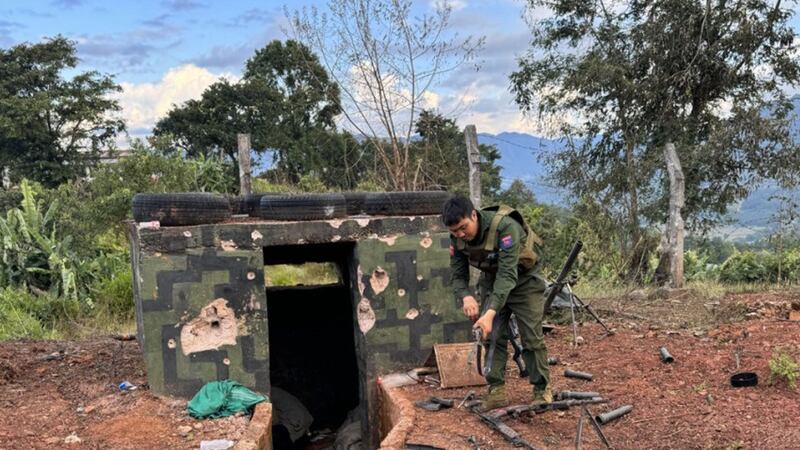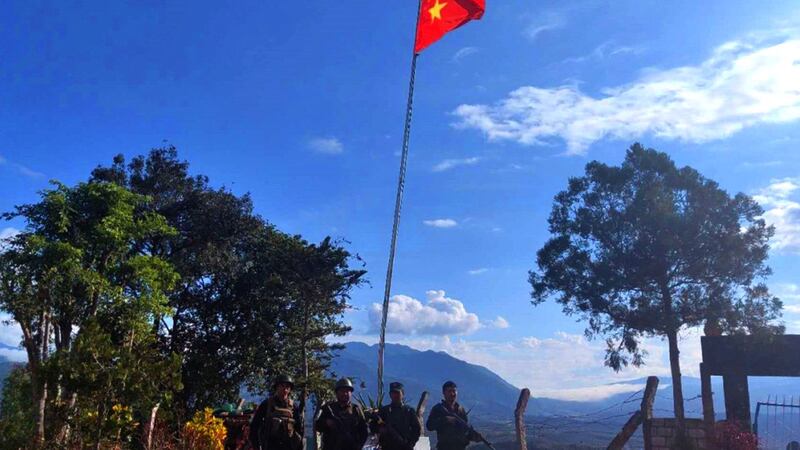Three Chinese naval vessels have arrived at Thilawa Port in Yangon for joint drills with Myanmar’s navy amid insurgent conflict along the neighboring nations’ shared border, according to the country’s military and pro-junta media reports.
Nearly 700 sailors with a Chinese naval task force landed at Myanmar’s largest city on Monday aboard the destroyer Zibo, frigate Jingzhou and replenishment vessel Qiandaohu to take part in a maritime security drill and a goodwill visit, the Commander-in-Chief of Defence Services website said.
Details about the date, location and format of the drills were not made publicly available.
Junta Deputy Information Minister Major-General Zaw Min Tun categorized the visit as typical of two “strategic partners” who have “established a strong friendship between militaries.”
But the arrival of the three vessels comes amid bilateral tensions stemming from a surge of conflict in northern Myanmar along the border with China since late October.
![Senior Myanmar naval officers [right] welcome members of the Chinese navy upon their arrival at Thilawa Port in Yangon, Myanmar, Monday, Nov. 27, 2023. (AFP/Myanmar's Military Information Team)](https://www.rfa.org/resizer/v2/ZUSKLQ6H3ZAIOKF26FOXECKIS4.jpg?auth=8e3cfd0cfed300d5fd671a53489afaf76dc9f3a0335ec9bee5c3427f2a80950b&width=800&height=434)
In the month since the "Three Brotherhood" Alliance of the Myanmar National Democratic Alliance Army, the Arakan Army and the Ta'ang National Liberation Army launched an offensive on Oct. 27 dubbed " Operation 1027" the rebels have made notable gains against the military in several key cities in Shan state in the country's northeast. The alliance claims to have captured more than 170 military outposts since the start of the campaign.
In an address to the National Defense and Security Council on Nov. 8, junta chief Senior-General Min Aung Hlaing said that the Myanmar National Democratic Alliance Army, or MNDAA, has been using drones to attack the military, which he noted “can easily be bought in China.”
Not long after, pro-junta supporters staged a protest in front of the Chinese Embassy in Yangon, accusing Beijing of supplying arms to the Three Brotherhood Alliance.
In the meantime, China’s People’s Liberation Army on Nov. 25 began conducting live-fire drills in southern Yunnan province near the border with Shan state.
Chinese state media has run footage of the drills involving armored vehicles, artillery shelling and small arms fire, saying they are aimed at “safeguarding national sovereignty, border stability and the lives and property of the people against repercussions from civil war in northern Myanmar.”
Shoring up ties
Hla Kyaw Zaw, a China-based analyst of Myanmar affairs, told RFA Burmese that the visit is meant to reinforce the trade relationship of the two neighboring nations amid the border conflict.
“The military recently raised an anti-Chinese voice, but now has praised the tour of Chinese vessels as a success in diplomatic relations,” he said. “China has made a lot of investments in its business across the world. It is also a major trade partner of more than 100 countries. So, China is seeking to maintain good relationships with its trade-partner countries.”
Political and military commentator Aung Myo, a former officer in the Myanmar military, told RFA that China’s visit is meant to show support for the junta.
“China has made a visit of navy vessels to offer their guarantee of a constructive, strategic relationship with Myanmar, and it is likely meant to relieve junta suspicions that China is involved in the armed conflict in northern Shan state,” he said. “Another message is to show that the influential power of China is standing with the [military] and its supporters.”

However, political commentator Than Soe Naing noted that the joint drills were scheduled before the start of Operation 1027 in northern Shan state, suggesting they are not meant to signal support for the junta.
“The visit of the navy vessels is likely to be part of a goodwill tour and does not indicate Chinese support for the junta in its armed conflict,” he said. “China has expressed an unwillingness to take any sides – either that of the military or the resistance forces – while calling for peace dialogue.”
On Oct. 27, the day that Operation 1027 began, China’s foreign ministry called for dialogue to end the conflict. Since then, there have been several high-level meetings between Chinese and junta officials in both China and Myanmar that have included talks on the fighting in Shan state, but clashes have continued, and the analysts RFA spoke with say there is no end in sight.

Attempts by RFA to contact the Chinese Embassy in Yangon for comment on the drills and the state of Myanmar-China relations went unanswered Tuesday, as did requests for comment to junta officials.
From Nov. 7-9, junta troops conducted drills alongside around 800 sailors and three destroyers from the Russian navy in the Bay of Bengal near Myeik township in southern Myanmar’s Tanintharyi region.
Translated by Aung Naing. Edited by Joshua Lipes and Malcolm Foster.
